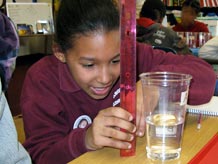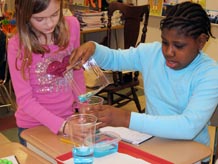How can we compare the volumes of liquids?
3. Test predictions


Typically, the predicted orders vary. This indicates that it's hard to compare volumes when the containers aren't the same. Have students brainstorm ways to test their predictions.
- How can we check our predictions?
- Can we think of a fair test to compare the volumes of water in the three containers?
Someone might suggest putting the three samples into identical containers so students can compare volumes — just as they did in earlier investigations. Alternatively, someone might suggest pouring the water from cups A, B, and C into a fourth container, one by one, and marking the level of each sample.
Distribute any necessary materials to the groups (e.g., some 20oz cups) and let them conduct their tests. Be sure students keep track of sample labels ("A," "B," or "C") and that they record their findings in their notebooks.
The volumes are the same. As students report their findings:
- Are the results surprising? How do you explain them?
- Which estimation strategies were successful and which were not?
Before moving on, get consensus on the following point:
- When the containers vary in shape or size, it's hard to tell with our senses how much more space one sample of water takes up than another.



